47 Davey Street, Hobart. Google Maps.
Opened 1857, replacing Collins St Independent Chapel.
For sale in 2012
PROPOSED NEW INDEPENDENT CHAPEL.
According to announcement a public meeting was held in Collins-street Independent Chapel last evening, the object being to take into consideration the necessity of building a new place of worship, and to appoint a committee to carry out the same. After the meeting had been opened by singing, reading, and prayer, the pastor, the Rev. G. Clarke, proceeded to give a short history of the church from its commencement, of which the following is an outline:-
On the 11th March, 1836, a number of individuals, who had been members of congregational churches in England, met at the house of Mr. Hopkins, the reconstituted themselves into a church, and elected the Rev. J. Nesbit their pastor. For some time they met at a place in Liverpool-street, but that being unsuitable, and the members unable to build a place of worship, Mr. Hopkins himself built the present chapel in Collins-street, which was to be used by the Congregationalists till the people who worshipped there were in a position to build a place for themselves. Mr. Hopkins has therefore for sixteen years placed the chapel at the service of the church gratuitously, the minister’s salary and other incidental expences being paid by the people. The church and congregation now think the time has arrived that they must rise and build a new chapel more commodious and in a better situation than the present one. The principle on which they purpose to act is to defray the cost of erection by voluntary contributions.
[continued]
The Courier, 10 June 1853
NEW INDEPENDENT CHAPEL.-We understand that the committee have already obtained the encouraging sum of £800 for the purpose of building a new place of worship in lieu of the one now used in Collins-street. No doubt a very handsome sum will be realized before the twelve months are over.
Colonial Times, 16 July 1853
THE VOLUNTARY PRINCIPLE.-We understand the Independents of Collins-street chapel have purchased a site for a new place of worship in Liver-pool-street for £1 800.
Colonial Times, 17 November 1853
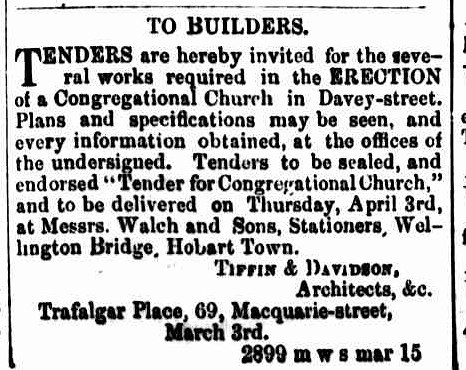
Tasmanian Daily News, 10 March 1856
THE NEW CONGREGATIONAL CHAPEL IN DAVEY-STREET.
The foundation stone of the new chapel intended for the use of the church and congregation under the pastorate of the Rev. G. Clarke, now worshipping in Collins-street, was laid with the usual ceremonials yesterday, at noon. When completed it will be one of the handsomest edifices of the kind in Hobart Town. The design is from the studio of Messrs. Tiffin and Davidson, of Macquarie-street. The style selected is that of the early English of the days of King John, a style of architecture which prevailed for about two hundred years, and has been revived with considerable success. The facade, when finished, will present the distinguishing characteristics of the style, consisting of a tower and breach spire (95 feet in the clear), with an entrance by one deeply recessed doorway. This opens into a porch, whence springs a staircase turning right and left, giving access to the galleries, while entrance to the body of the building will be obtained by means of side doors leading out of the porch. The chapel will consist of a nave, two aisles, a chancel and vestry ; schoolrooms are designed to be built at the back. The roof will be what is called open timbered, consisting entirely of hardwood boarded and slated ; and supported by nave piers formed of eight alternated clustered and octagonal columns. The pulpit, formed of cedar handsomely carved, will be placed at the junction of the nave and chancel, which last will be lighted by a three light pointed window filled with stained glass. The exterior will be relieved by projecting buttresses. The side lights will be plain, pointed, with splayed jambs. The building throughout will be built of freestone, from the quarry at Risdon, and indeed, so far as practicable, colonial material alone is to be used in its construction. The contract has been taken by Mr. James Pretty, and it is expected that the building will be ready for the opening services about July next. The cost will be something under £5000. All the most modern improvements have been adopted by the architects, and introduced. The new chapel will contain no pews, but open benches (cedar) only ; and will comprise sittings, in the body and galleries, for about 700 persons. This increased accommodation has long been necessary, the chapel in Collins-street being far too limited for the requirements of the rapidly-increasing congregation and church.
[continued]
The Courier, 31 July 1856
The foundation stone of the new Congregational Chapel, Davey-street, was laid last week by Mr. H. Hopkins. The site purchased for the building is opposite St. David’s burial ground, and between Murray and Harrington-streets; the plans and specifications have been prepared by Messrs. Tiffin and Davidson, and the chapel which is estimated to cost £5000, will be erected within twelve months.
Cornwall Chronicle, 6 August 1856
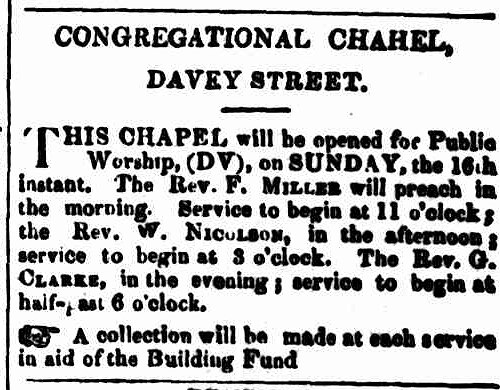
Colonial Times, 11 August 1857
THE OPENING OF THE CONGREGATIONAL CHURCH, DAVEY STREET.
“These temples of His grace,
How beautiful they stand!
The honor of our native place,
The bulwarks of our land.”
The dedication of the New Church lately erected in Davey-street to the worship of Almighty God took place on Sunday last. Before, however, entering into a narrative of this event, a brief history of the circumstances which led to the erection of this handsome structure may not be uninteresting.
About four years since, the congregation worshipping in Collins-street Chapel first determined upon a new and more suitable place for public worship. Accordingly, a Building Committee was appointed, who at once commenced to raise the necessary funds. After a certain sum had been obtained, a site was purchased in the lower part of Liverpool-street for £1800. When, however, the purchase was completed, circumstances arose which rendered it desirable to select another locality. Accordingly, the land in Liverpool street was disposed of, and the site on which the new church stands was purchased. Matters having thus progressed, arrangements were made for commencing the church, and a design by Messrs, Tiffin and Davidson having been approved, and a contract for the building entered into with Mr. James Pretty, the First Stone was laid on the 31st July, 1856, by Henry Hopkins, Esq, on which occasion an exposition of the religious belief and principles of church government prevailing amongst the Congregational churches was delivered by the minister of the congregation, the Rev. G. Clarke.
The Church is in the style of early English architecture of the days of King John. The façade presents the distinguishing characteristics of the style, consisting of a tower and broach spire, (94 feet high in the clear) with an entrance by one deeply recessed doorway. This opens into a porch, whence springs a staircase turning right and left, giving access to the galleries, while entrance to the body of the building is obtained by means of side doors also leading out of the porch. The church consists of a nave, two aisles, a chancel, and vestry. The roof is open timbered, consisting of hard wood boarded and slated, supported by nave piers formed of eight alternated clustered and octagonal columns ; the exterior is relieved by projecting buttresses. The chancel is lighted by a three-light-pointed window bordered with stained glass. The side lights are plain, pointed with splayed jambs. The pulpit, formed of cedar, handsomely carved, is placed at the junction of the nave and chancel, and instead of pews (those disfigurements to most modern places of worship) open benches also of cedar have been adopted, by which accommodation for upwards of 700 persons is obtained, The church is built of freestone from the Risdon quarries, and the manner in which the work has been carried out is creditable to the contractor Mr. Pretty, and the architects Messrs. Tiffin & Davidson. Mr. Tiffin having left the colony the work has been superintended latterly by Mr. Davidson. The total cost, including purchase of site, the church architects’ fees, the erection of the wall, iron railing in front, and gas fittings, &c , has not exceeded £7000, and it is gratifying to state that at the time of the opening only £600 of this large sum remained unpaid. It is also still more gratifying to announce that, owing to the munificence of those who on Sunday assembled within the walls of the sacred edifice, this debt was further reduced to the sum of £256. It is worthy of remark, that the church has been built and the outlay met solely from voluntary contributions raised chiefly by the congregation, but with the aid of the members of the denomination, as well as of other Christian bodies, including several members of the Church of England.
On Sunday, morning worship ,was commenced by singing the anthem, “I will arise.” The minister, the Rev. G Clarke, offered the prayer of dedication. The sermon was preached by the Rev. F Miller minister at Brisbane street chapel, from Psalm xlviii 9, “We have thought of Thy loving kindness, O God, in the midst of Thy temple”. In his discourse the rev gentleman dwelt upon and illustrated the object of contemplation the loving kindness of the Lord and scene of that contemplation-the House of God.
In the afternoon the Rev. W. Nicolson, minister at Chalmers’s Free Church, officiated and preached from Exodus xl. 33, 34, “So Moses finished the work. Then a cloud covered the tent of the congregation, and the glory of the Lord filled the tabernacle.” Mr. Nicolson observed that the completion of a place of worship both according to the Old and New Testament, was a fit reason for celebration. The uses of places of worship were purely spiritual, and the glory of the Lord was manifested by active exertions in the cause of Christ, and by the holy lives of His followers.
The minister of the congregation, the Rev. George Clarke, conducted the evening service, and preached from Mark xvi. 15, “Preach the gospel to every creature.” After some remarks on the persuasive power of the Gospel Mr Clarke considered his subject under the following divisions :-1. The condition which the gospel presupposes 2. The blessings it announces. 3 The assurance it brings. The church was well filled at each of the services, and the collections amounted in the aggregate to the sum of £345.
Colonial Times, 18 August 1857
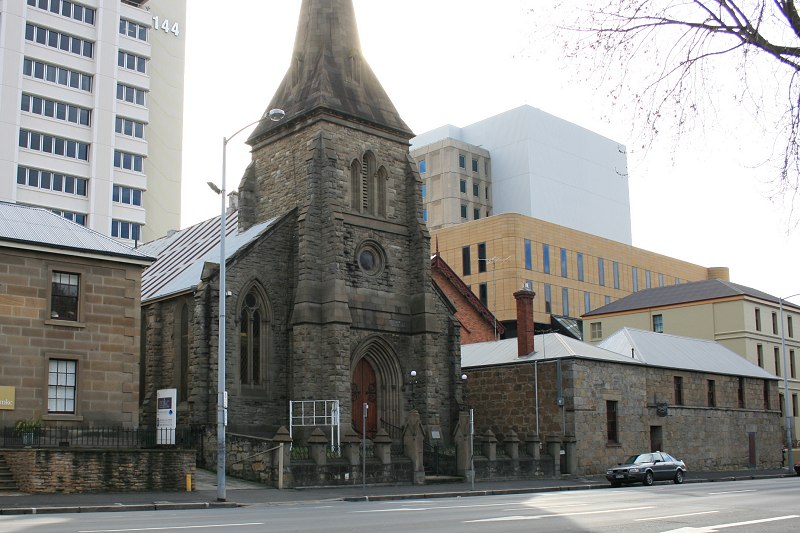

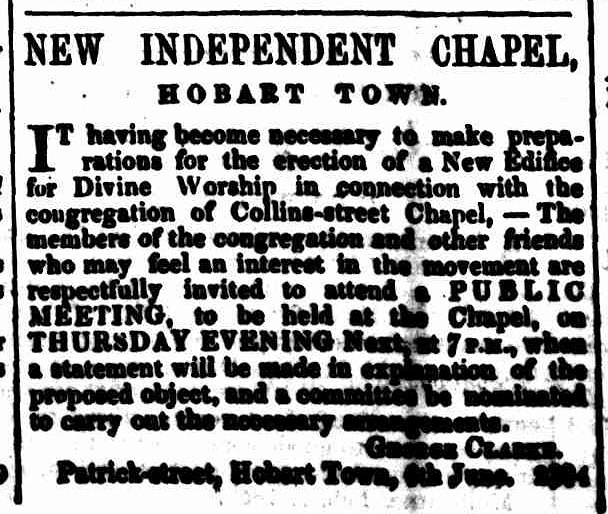
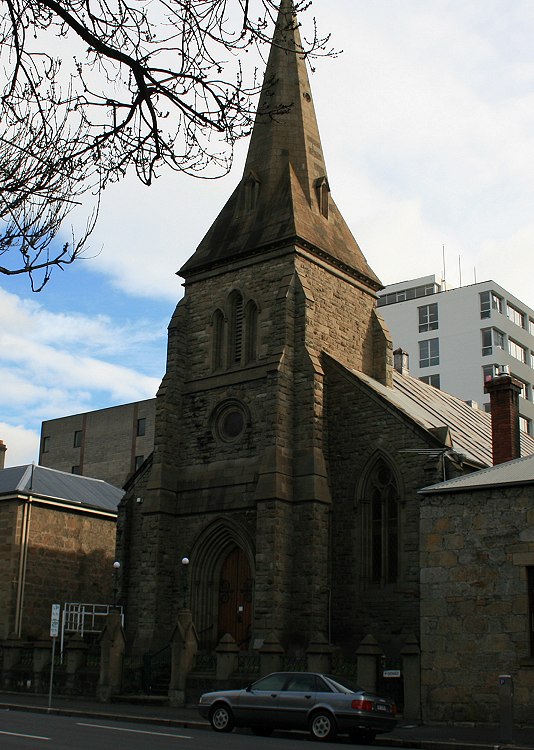
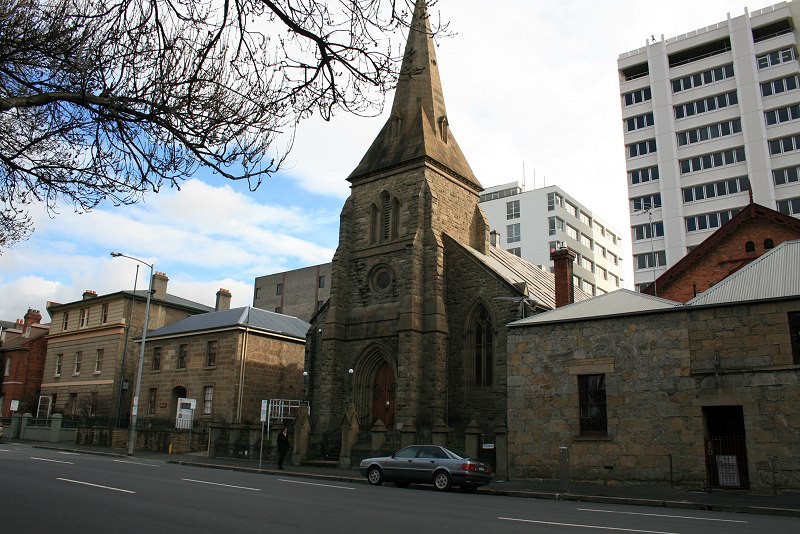
Paddy Byers
July 30, 2017 at 9:46pmI worked at this site for over a decade when the community organisation, Colony 47 Inc. was located there.
I have lived in South Hobart next door to what used to be the burial ground associated with this church.
Do you have any information about the burial ground?
Monissa Whiteley
August 17, 2017 at 11:54amI don’t seem to have anything, other than dates (1841-1894). Sorry!
Jenny Kay
February 19, 2021 at 12:29ammy great grand Aunty Elizabeth Nisbet was christened in this church in 1859
Vaughn Thompson
January 15, 2022 at 1:13amMy great grandfather and mother got married there in 1858 .